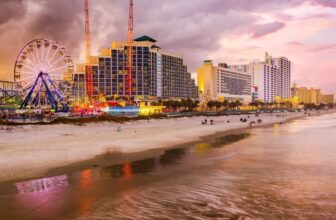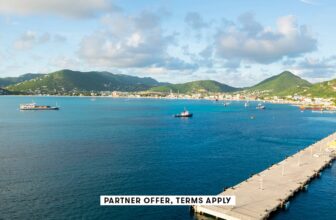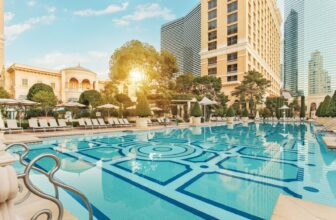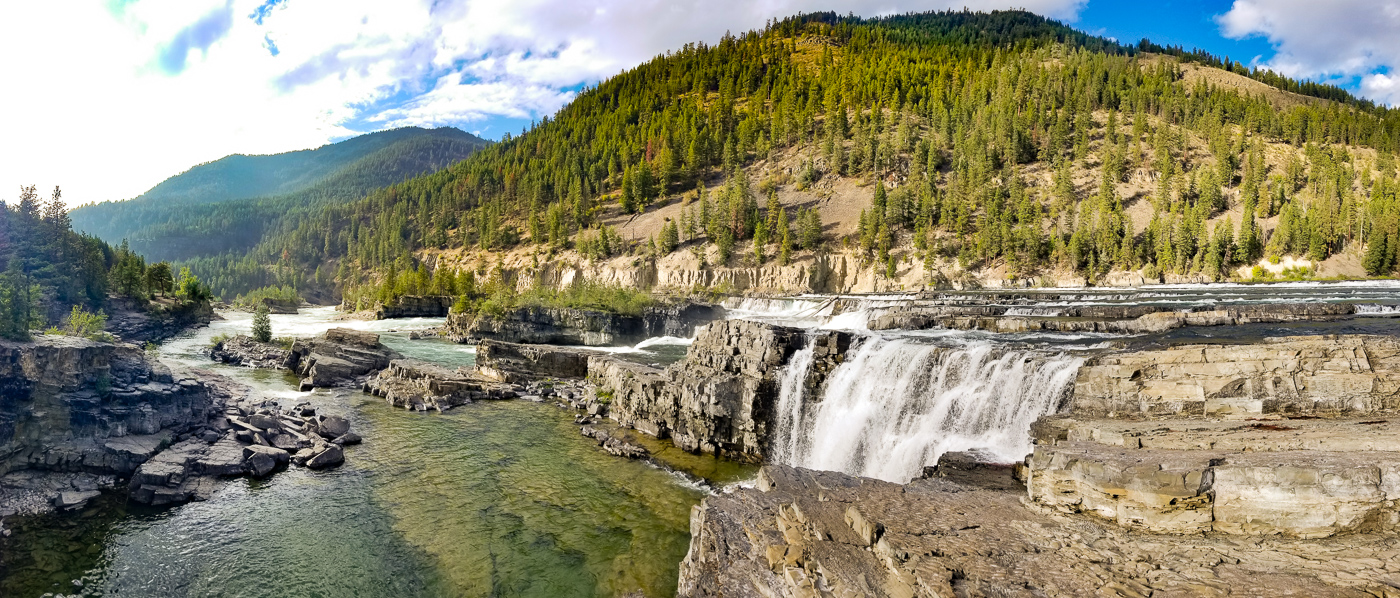
[ad_1]
Everyone wants to visit Glacier National Park…like 3 million people a year. But what many park-goers don’t realize is that most of Western Montana was carved by the same glacial activity, offering so many other stunning mountains, lakes, rivers, and forests—with a fraction of the tourists. To help more people find the lesser-known gems and keep them pristine, we took our experience as off-grid RVers with a green heart, and partnered with Glacier Country Tourism for a #RecreateResponsibly road trip. Over the course of 12 days, we traveled from the Bitterroot Mountains to the far north of Kootenai Country, through three national forests, dynamic Native American territories, charming small towns, the biggest freshwater lake in the West, and a ton more in between. Here are some of our favorite Western Montana road trip destinations and the ways you can leave these places better than you found them.
Biking the Route of the Hiawatha
 Spanning the Idaho and Montana border, the Route of the Hiawatha is one of the crown jewels of the US’s rails-to-trails system. When building the railroad line from Chicago to Tacoma in the early 20th-century, the crew reached the Bitterroot Mountains and it was the toughest terrain they’d encountered. To create this 15-mile stretch, they bore 10 tunnels (some over a mile long) and built 7 trestle bridges towering over the forest. And all that hard work is still paying off with this unbelievable bike trail. To get geared up, we went to Lookout Pass Resort for bike rentals and a rack, then drove to the Montana side to start the ride. With a gentle downhill pitch and wide dirt trail, it’s all about enjoying the sweeping mountain views and engineering marvels lining the way. To make it even easier for all ages, Lookout Pass offers a shuttle with a guide to entertain you all the way back to the parking lot. Call us slackers, but the return shuttle allowed us to take our sweet time for countless photo stops, reading the dozens of interpretive signs, enjoying a picnic, and hiking up a waterfall. Watch this video from our ride.
Spanning the Idaho and Montana border, the Route of the Hiawatha is one of the crown jewels of the US’s rails-to-trails system. When building the railroad line from Chicago to Tacoma in the early 20th-century, the crew reached the Bitterroot Mountains and it was the toughest terrain they’d encountered. To create this 15-mile stretch, they bore 10 tunnels (some over a mile long) and built 7 trestle bridges towering over the forest. And all that hard work is still paying off with this unbelievable bike trail. To get geared up, we went to Lookout Pass Resort for bike rentals and a rack, then drove to the Montana side to start the ride. With a gentle downhill pitch and wide dirt trail, it’s all about enjoying the sweeping mountain views and engineering marvels lining the way. To make it even easier for all ages, Lookout Pass offers a shuttle with a guide to entertain you all the way back to the parking lot. Call us slackers, but the return shuttle allowed us to take our sweet time for countless photo stops, reading the dozens of interpretive signs, enjoying a picnic, and hiking up a waterfall. Watch this video from our ride.
#RecreateResponsibly Tip: Plan Ahead. Bring a raincoat and headlamp to be ready for the tunnels.
Catching a County Fair
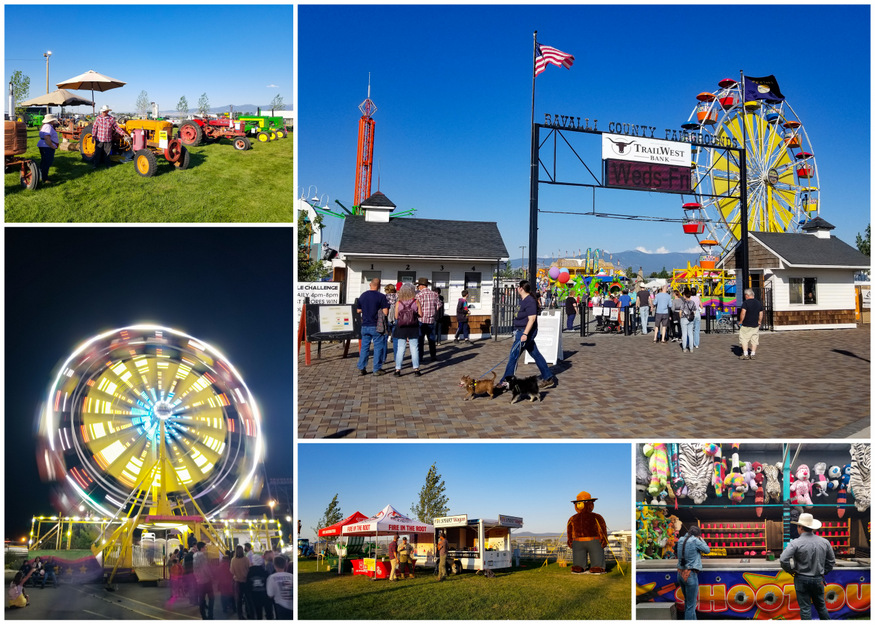 From summer to fall, there are fairs all over Montana and we were in just in time for one of the biggest events in Ravalli County. Amusement rides, cornhole tournaments, bake-offs, livestock demonstrations, vintage car shows, and a full-blown rodeo…this was a cultural affair decked in cowboy boots. And we may be city folk, but we got in with the best of them, chowing down on huckleberry pie and cheering on the wagon races. In addition to the rodeo clown, who was our favorite character at the fair? Smokey Bear. He was representing at the Bitterroot National Forest booth, offering info on camping and fire safety for locals and visitors alike. Thanks, Smokey!
From summer to fall, there are fairs all over Montana and we were in just in time for one of the biggest events in Ravalli County. Amusement rides, cornhole tournaments, bake-offs, livestock demonstrations, vintage car shows, and a full-blown rodeo…this was a cultural affair decked in cowboy boots. And we may be city folk, but we got in with the best of them, chowing down on huckleberry pie and cheering on the wagon races. In addition to the rodeo clown, who was our favorite character at the fair? Smokey Bear. He was representing at the Bitterroot National Forest booth, offering info on camping and fire safety for locals and visitors alike. Thanks, Smokey!
#RecreateResponsibly Tip: Know Before You Go. Wildfire season is a very real thing in the West, check MTFireInfo.org for the latest fire status and restrictions.
Kettlehouse Amphitheater
 Swinging the cultural pendulum, we went from a county fair to an indie rock concert at Montana’s premier music venue. The state-of-the-art Kettlehouse Amphitheater is tucked in a notch of the mountains at the foot of the Blackfoot River (yea, the one Brad Pitt was fishing in A River Runs Through It), earning it a spot in as one of Top 10 Amphitheaters in the World, according to Pollstar. Adding to the cool factor, it’s adjacent to the Kettlehouse Brewery, and fresh craft beer is delivered right to your concert seat. We saw Death Cab for Cutie and they were awesome, though it barely matters what band is in town…the venue is so extraordinary, you’re gonna have a great night.
Swinging the cultural pendulum, we went from a county fair to an indie rock concert at Montana’s premier music venue. The state-of-the-art Kettlehouse Amphitheater is tucked in a notch of the mountains at the foot of the Blackfoot River (yea, the one Brad Pitt was fishing in A River Runs Through It), earning it a spot in as one of Top 10 Amphitheaters in the World, according to Pollstar. Adding to the cool factor, it’s adjacent to the Kettlehouse Brewery, and fresh craft beer is delivered right to your concert seat. We saw Death Cab for Cutie and they were awesome, though it barely matters what band is in town…the venue is so extraordinary, you’re gonna have a great night.
#RecreateResponsibly Tip: Always Recycle. We love that Kettlehouse Amphitheater was all about minimizing waste with recycling, compost, and cardboard water bottles, though traveling in rural areas can make it trickier to keep up those good habits. If you don’t see recycling right away, stash it in your trunk until you see that service—you’ll find it eventually!
Garnet Ghost Town
 Being the Treasure State, Montana has old mining towns all throughout the mountains, with the best-preserved being Garnet. Taking a turn off the nicely paved Route 200 and onto the rugged Garnet Range Backcountry Byway, we wound through the mountains for 11 miles. Following a short hiking trail into a valley, we got a view over this 130-year-old time capsule. Not your average ramshackle mining town, Garnet had four hotels, three livery stables, two barbershops, a union hall, school, candy shop, doctor’s office, and 13 saloons. Eventually, a gold scarcity and the 1913 fire drove the town into ghost status, but when prohibition and the depression era hit, their hidden saloons and gold claims got a second wind. We loved wandering through the old buildings, many with their original fixtures and relics, and up the hill to the 1890s miners’ cabins. Take a half-hour hike along the Sierra Mine Loop Trail and you’ll find old gold claims tucked in the pines.
Being the Treasure State, Montana has old mining towns all throughout the mountains, with the best-preserved being Garnet. Taking a turn off the nicely paved Route 200 and onto the rugged Garnet Range Backcountry Byway, we wound through the mountains for 11 miles. Following a short hiking trail into a valley, we got a view over this 130-year-old time capsule. Not your average ramshackle mining town, Garnet had four hotels, three livery stables, two barbershops, a union hall, school, candy shop, doctor’s office, and 13 saloons. Eventually, a gold scarcity and the 1913 fire drove the town into ghost status, but when prohibition and the depression era hit, their hidden saloons and gold claims got a second wind. We loved wandering through the old buildings, many with their original fixtures and relics, and up the hill to the 1890s miners’ cabins. Take a half-hour hike along the Sierra Mine Loop Trail and you’ll find old gold claims tucked in the pines.
#RecreateResponsibly Tip: Take only photographs. Like any historic site, you may come across little artifacts as you wander about town; leave them behind and help keep the story of Garnet in context.
Seeley Lake & The Clearwater Canoe Trail
 Between the Bob Marshall Wilderness and the Mission Mountains lies the Seeley-Swan Valley Chain of Lakes and the ever-popular Clearwater River Canoe Trail. We rented SUP boards from Tamaracks Resort and they dropped us off at the put-in. Paddling this 3.5-mile meandering waterway through the willow marsh with mountain views on all sides was glorious. When we reached the river’s end, we were greeted with a floating garden of lily pads and a beach to enjoy the expansive Seeley Lake. Conveniently, there is a half-hour hiking trail to connect back to the put-in spot; if you rented from Tamaracks, just keep paddling for 20 minutes to reach their lakefront property. FYI, this historic resort is a charmer with great cabins and campsites if you want to stay awhile and soak up the lake life. Another great lodging and dining option is Double Arrow Lodge. We went for dinner at their 1930s log-cabin restaurant and indulged in truffle root vegetable risotto and Grand Marnier chocolate mousse cake. We earned it with that paddling trip, right?
Between the Bob Marshall Wilderness and the Mission Mountains lies the Seeley-Swan Valley Chain of Lakes and the ever-popular Clearwater River Canoe Trail. We rented SUP boards from Tamaracks Resort and they dropped us off at the put-in. Paddling this 3.5-mile meandering waterway through the willow marsh with mountain views on all sides was glorious. When we reached the river’s end, we were greeted with a floating garden of lily pads and a beach to enjoy the expansive Seeley Lake. Conveniently, there is a half-hour hiking trail to connect back to the put-in spot; if you rented from Tamaracks, just keep paddling for 20 minutes to reach their lakefront property. FYI, this historic resort is a charmer with great cabins and campsites if you want to stay awhile and soak up the lake life. Another great lodging and dining option is Double Arrow Lodge. We went for dinner at their 1930s log-cabin restaurant and indulged in truffle root vegetable risotto and Grand Marnier chocolate mousse cake. We earned it with that paddling trip, right?
Hiking Holland Lake & Falls
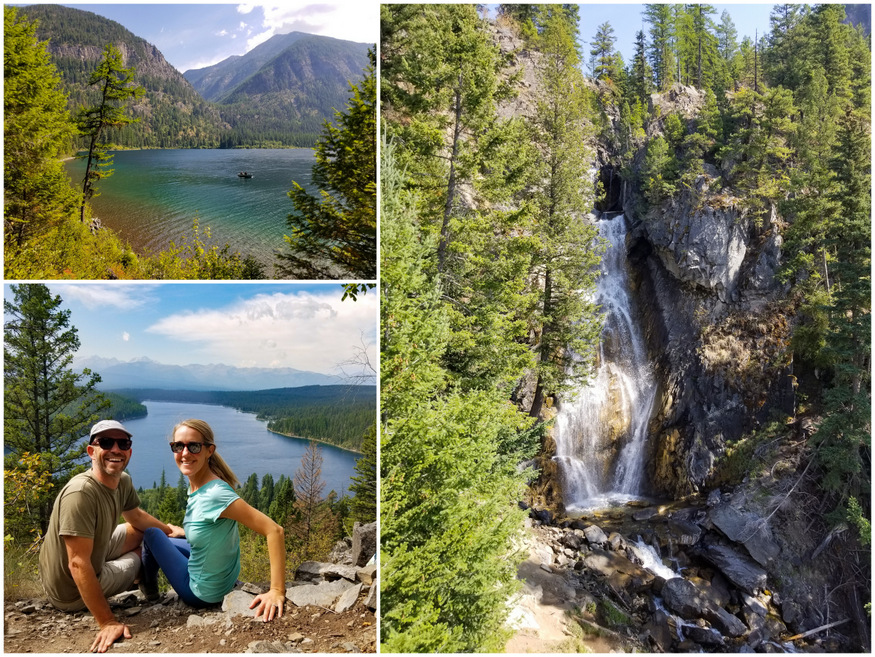 On the northside of Seeley-Swan Valley is one of our favorite hikes in Montana: Holland Falls Nature Trail. With just a quick walk through the tamarack and alpine forest, you reach the turquoise Holland Lake surrounded by sheer peaks. It was so gorgeous we could have called it there, but following the shoreline, the views kept getting better as we steadily climbed to the 40-foot waterfall. If you’re up for a bit of rock scrambling (not recommended for kids), a steep trail will bring you from the bottom of the falls to a breathtaking view over the lake.
On the northside of Seeley-Swan Valley is one of our favorite hikes in Montana: Holland Falls Nature Trail. With just a quick walk through the tamarack and alpine forest, you reach the turquoise Holland Lake surrounded by sheer peaks. It was so gorgeous we could have called it there, but following the shoreline, the views kept getting better as we steadily climbed to the 40-foot waterfall. If you’re up for a bit of rock scrambling (not recommended for kids), a steep trail will bring you from the bottom of the falls to a breathtaking view over the lake.
#RecreateResponsibly Tip: Brush it Off. At the start of this trailhead, the forest service provides a boot brush. Wipe off your shoes before and after the hike to prevent the seeds and spores of invasive species from spreading. While not every trail offers this, it’s still a great practice to brush off or clap your shoes together when entering and departing new wilderness areas.
Flathead Lake
 Did you know Montana’s Flathead Lake is the largest freshwater lake west of the Mississippi? The 185 miles of shoreline are dotted with cute towns, orchards, state parks, and native land. We drove the full circumference going counterclockwise, starting from Big Fork. This town was adorable, with a great little theater, art galleries, ice cream shops, and bars where you can hitch up your horse. Driving down the east side of the lake, the slopes were covered with fruit trees. We stopped at Bowman Orchards, a century-old and fifth-generation family farm, with a specialty in Rainier and Lapin cherries. The whole family, from the teenagers to the grandparents, was at work wrapping up a great season. If you’re an RVer and a Harvest Host Member, both Bowman Orchards and East Shore Smokehouse (a fun restaurant with a big grassy field) will let you stay the night in exchange for getting some of their goodies. Win, win!
Did you know Montana’s Flathead Lake is the largest freshwater lake west of the Mississippi? The 185 miles of shoreline are dotted with cute towns, orchards, state parks, and native land. We drove the full circumference going counterclockwise, starting from Big Fork. This town was adorable, with a great little theater, art galleries, ice cream shops, and bars where you can hitch up your horse. Driving down the east side of the lake, the slopes were covered with fruit trees. We stopped at Bowman Orchards, a century-old and fifth-generation family farm, with a specialty in Rainier and Lapin cherries. The whole family, from the teenagers to the grandparents, was at work wrapping up a great season. If you’re an RVer and a Harvest Host Member, both Bowman Orchards and East Shore Smokehouse (a fun restaurant with a big grassy field) will let you stay the night in exchange for getting some of their goodies. Win, win!
Flathead’s Wild Horse Island & Camp Kapapa
 Cruising up the westside of the lake, we had our eyes set on Flathead’s largest isle, Wild Horse. This 2,160-acre mountainous expanse is where the Kootenai people historically hid their horses from warring tribes and where their equine ancestors still roam free. Only accessible by boat, this state park called for a kayak and hiking trip! We set off from the town of Dayton and after a scenic hour paddle, we reached Skeeko Bay and its extensive network of trails. We hiked up the mountain, keeping an eye out for their resident wild horses, bighorn sheep, mule deer, and relics from the early 20th-century settlers. We reached the peak for panoramic views of the surrounding islands, mountains, and lake, then meandered our way down to Eagle Cove to finish out this fantastic hiking loop. After a big day of outdoor adventure, we wanted to treat ourselves to a night at Camp Kapapa, a brand new glamping camp on the Flathead Reservation. This property has been in Keya Birdsbill’s family for generations and it was always her grandmother’s dream to share the land in its natural state and with its Kootenai traditions. This summer Keya and her husband Louie opened Camp Kapapa (which means “grandparent” in the Kootenai language) in her honor. Right along the shore, they have teepees, a wall tent, deluxe tent sites, and a one-of-kind teepee cabin, each adorned with tribal motifs and views to the lake. We absolutely fell in love with this glamping camp; to see and read more about it, check out our Camp Kapapa Instagram gallery.
Cruising up the westside of the lake, we had our eyes set on Flathead’s largest isle, Wild Horse. This 2,160-acre mountainous expanse is where the Kootenai people historically hid their horses from warring tribes and where their equine ancestors still roam free. Only accessible by boat, this state park called for a kayak and hiking trip! We set off from the town of Dayton and after a scenic hour paddle, we reached Skeeko Bay and its extensive network of trails. We hiked up the mountain, keeping an eye out for their resident wild horses, bighorn sheep, mule deer, and relics from the early 20th-century settlers. We reached the peak for panoramic views of the surrounding islands, mountains, and lake, then meandered our way down to Eagle Cove to finish out this fantastic hiking loop. After a big day of outdoor adventure, we wanted to treat ourselves to a night at Camp Kapapa, a brand new glamping camp on the Flathead Reservation. This property has been in Keya Birdsbill’s family for generations and it was always her grandmother’s dream to share the land in its natural state and with its Kootenai traditions. This summer Keya and her husband Louie opened Camp Kapapa (which means “grandparent” in the Kootenai language) in her honor. Right along the shore, they have teepees, a wall tent, deluxe tent sites, and a one-of-kind teepee cabin, each adorned with tribal motifs and views to the lake. We absolutely fell in love with this glamping camp; to see and read more about it, check out our Camp Kapapa Instagram gallery.
#RecreateResponsibly Tip: Respect Wildlife. Whether on Wild Horse Island or in Glacier National Park, Montana is chock full of wildlife. As tempting as it is to get close for a good photo, keep your distance and do not disturb them. Be particularly mindful of bears and follow these safety tips.
The Northwest Corridor: Eureka
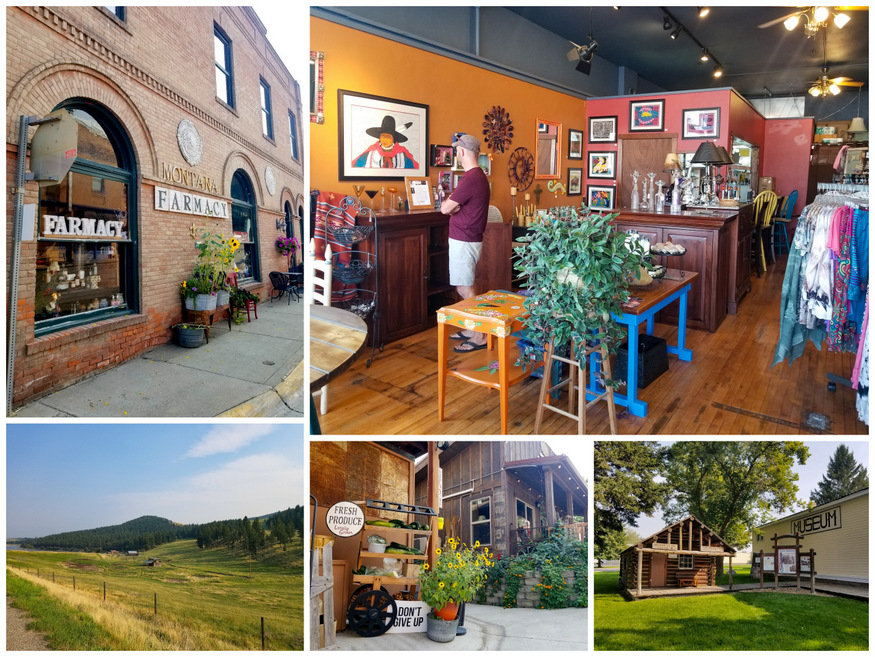 Heading into the Northwest Corridor towards the Canadian border, the wilderness gets wilder and the small towns get smaller. Steamboats and railways were the only way to get into the glacial and gold-rich hills of Tobacco River Valley until the early 1900s and it still feels just as remote. For a look into the past, we went to Eureka’s Tobacco Valley Historical Village to explore its collection of hand-hewn buildings, from old cabins to churches to schoolhouses. Though exploring the main street of modern-day Eureka was a whole lot more contemporary than we would have imagined, with cool boutiques, coffee shops, movie theater, and even a world-fusion, vegan-friendly cafe. Adding to the unexpected, Montana’s #1 golf course, The Wilderness Club, is in this town!
Heading into the Northwest Corridor towards the Canadian border, the wilderness gets wilder and the small towns get smaller. Steamboats and railways were the only way to get into the glacial and gold-rich hills of Tobacco River Valley until the early 1900s and it still feels just as remote. For a look into the past, we went to Eureka’s Tobacco Valley Historical Village to explore its collection of hand-hewn buildings, from old cabins to churches to schoolhouses. Though exploring the main street of modern-day Eureka was a whole lot more contemporary than we would have imagined, with cool boutiques, coffee shops, movie theater, and even a world-fusion, vegan-friendly cafe. Adding to the unexpected, Montana’s #1 golf course, The Wilderness Club, is in this town!
Tobacco River & Campground Cleanup
 Just six miles west of Eureka in the Kootenai National Forest, there is the incredible (and free!) Tobacco River Campground. We saw a fire-ring right along the water and quickly set up camp to enjoy the last moments of sunset, watch the ospreys fish, and cook dinner over the fire. (Watch our fire safety TikTok). In the morning, the wildlife watching continued like an episode out of the Discovery Channel. Gliding herons, dive-bombing eagles, wave-riding ducks, and spawning Kokanee salmon were all putting on an amazing show. As we were breaking down camp, we saw two Forest Service volunteers making the rounds with their trash bags so asked if we could join their clean-up. They were so grateful for the help, that they turned it into a nature walk, teaching us about the native edible berries, medicinal plants, invasive species, and animal tracks…then gifted us a homemade jar of huckleberry jam!
Just six miles west of Eureka in the Kootenai National Forest, there is the incredible (and free!) Tobacco River Campground. We saw a fire-ring right along the water and quickly set up camp to enjoy the last moments of sunset, watch the ospreys fish, and cook dinner over the fire. (Watch our fire safety TikTok). In the morning, the wildlife watching continued like an episode out of the Discovery Channel. Gliding herons, dive-bombing eagles, wave-riding ducks, and spawning Kokanee salmon were all putting on an amazing show. As we were breaking down camp, we saw two Forest Service volunteers making the rounds with their trash bags so asked if we could join their clean-up. They were so grateful for the help, that they turned it into a nature walk, teaching us about the native edible berries, medicinal plants, invasive species, and animal tracks…then gifted us a homemade jar of huckleberry jam!
#RecreateResponsibly Tip: Leave it Better Than You Found It. Whenever you’re at a campsite or on the trail, do your part to keep it clean. We like to hike with a trash bag and pinchers so we never have to think twice about picking things up.
Libby & The Chainsaw Carving Championships
Taking the Koocanusa Scenic Byway along its namesake lake and into the Cabinet Mountains, we reached the spunky little city of Libby. As a former asbestos mining town, it had a bad wrap for a while, but Libby is reinventing itself as an adventure and cultural capital of the Northwest Corridor. It regularly hosts events like the Riverfront Blues Festival, Libby Logger Days, The Irish Fair, and the unbelievable Kootenai Country International Chainsaw Carving Championship. We had the great fortune of seeing the “Clash of the Carvers” and watch twenty of the world’s best, from Zimbabwe, Mongolia, Russia, Canada, USA, and more, face-off. They get an eight-foot log and four days to turn it into a masterpiece, plus the added challenge of daily 90-minute quick carves for the ongoing auction. Even in one day of walking around the open-air workshops, we were amazed at how much the artwork evolved. From sawing to chiseling, sanding, torching, and staining, these works were quickly refined to perfection. The night before the finals, the town went wild and we went with them. Alongside our new Montana buddy and former carver, Gary, we bar hopped from the Cabinet Mountain Brewery (aka The Living Room of Libby) to the Mint, where beers are still kept cold in wooden ice chests. The next day all the masterworks were lined up and auctioned off in a storm of bidders, driving prices upwards of $10,000. Watch the video above to see the sawdust fly and the good times rip.
Kootenai Falls & Swinging Bridge
Seven miles west of Libby, when the cliffs along the highway turn into a rainbow of colors and the river rages, you’ve reached Kootenai Falls. This cascade is one of the largest free-flowing waterfalls in the northwest, but it’s not the height or width that makes your jaw drop, it’s everything else. 1.5 billion-year-old rocks create a staircase for these falls to swiftly and gracefully step down the Kootenai River, then swoop around islands and down a craggy narrow canyon. We walked the short nature trail to the water and thought the first lookout was the view of views, but new waterfalls and islands kept appearing all the way to the main cascade. No crowding onto a viewing platform, you can walk right up to the falls, sit at the edge and feel the full rush. Head downstream and you’ll reach the swinging bridge for one last look at arguably one of the prettiest waterfalls in the States.
Ross Creek Cedars & Giving Back
 On our last day in Western Montana, we got up early to explore Ross Creek Cedars Scenic Area. Apparently, we got there even before the rangers, because there was a huge fallen tree blocking the road. Did we turn around? Heck no, Buddy comes packing with 102 horsepower, a hatchet, and rope! We knew you wouldn’t believe our 1985 camper could haul 4,000+ pounds of timber, so Anne shot this video of Buddy’s glory moment. We cleared the road for all and pressed on to the ancient grove of 1,000-year-old trees. Strolling the mile-long loop, we craned our necks to look up at the lush canopy 175 feet above us. On our way out we noticed a box that said that this grove is maintained by the Three Rivers Ranger District, with the help of visitor donations. Having just hiked, paddled, and camped in so many incredible public lands around Montana, we were moved to slip in a $100 bill.
On our last day in Western Montana, we got up early to explore Ross Creek Cedars Scenic Area. Apparently, we got there even before the rangers, because there was a huge fallen tree blocking the road. Did we turn around? Heck no, Buddy comes packing with 102 horsepower, a hatchet, and rope! We knew you wouldn’t believe our 1985 camper could haul 4,000+ pounds of timber, so Anne shot this video of Buddy’s glory moment. We cleared the road for all and pressed on to the ancient grove of 1,000-year-old trees. Strolling the mile-long loop, we craned our necks to look up at the lush canopy 175 feet above us. On our way out we noticed a box that said that this grove is maintained by the Three Rivers Ranger District, with the help of visitor donations. Having just hiked, paddled, and camped in so many incredible public lands around Montana, we were moved to slip in a $100 bill.
#RecreateResponsibly Tip: Pitch In. It takes more than government employees to keep public lands thriving. Donate, volunteer, and advocate for the outdoors whenever you can.
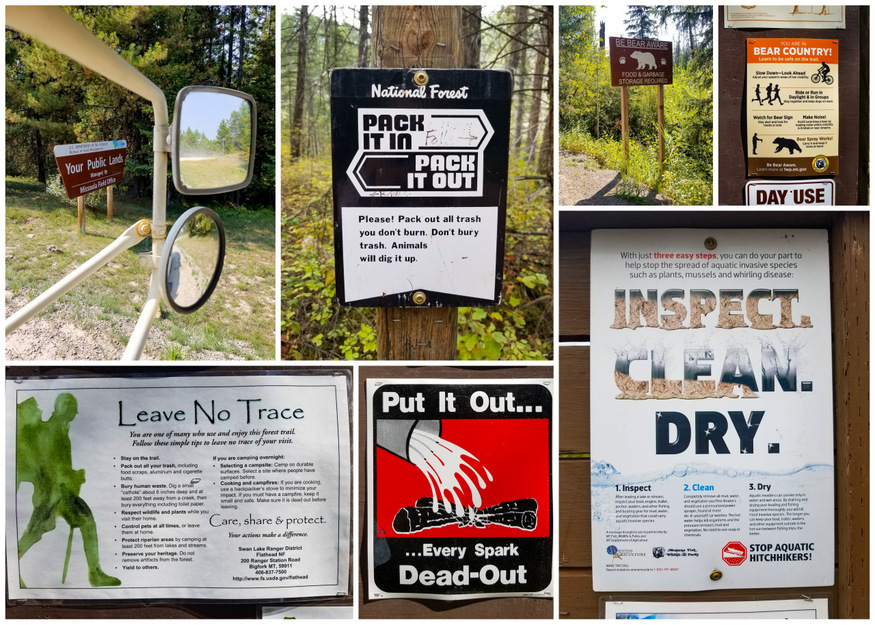 The rugged beauty of Western Montana is what draws millions of people here. We hope you visit, take an epic road trip, and become a steward for its wild places. For more of our
The rugged beauty of Western Montana is what draws millions of people here. We hope you visit, take an epic road trip, and become a steward for its wild places. For more of our
A big thank you to Glacier Country Montana for inviting us to share the #RecreateResponsibly message with travelers and for sponsoring our Western Montana road trip. And for featuring our “How to Boondock Like a Pro: The Glacier Country Guide to Free Camping” on GlacierMT.com. As a thank you to the region and to keep up our “Bloggers Give Back” commitment, we’re donating $325 of our earnings to the following non-profits: Clark Fork Coalition, The Ross Creek Cedars, and RecreateResponsibly.org.
[ad_2]



